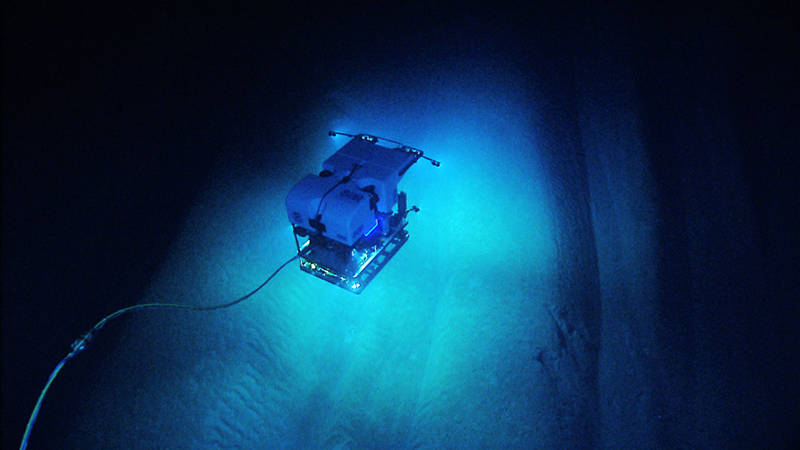
ROV Deep Discoverer explores the interesting geomorphology of Bryant Canyon. Image courtesy of NOAA Okeanos Explorer Program, Gulf of Mexico 2014 Expedition. Download larger version (jpg, 1.5 MB).

ROV Deep Discoverer explores the interesting geomorphology of Bryant Canyon. Image courtesy of NOAA Okeanos Explorer Program, Gulf of Mexico 2014 Expedition. Download larger version (jpg, 1.5 MB).
Okeanos Explorer EX1402L3
Dive 09: Bryant Canyon Shallow. Video courtesy of NOAA Office of Ocean Exploration and Research. Download (mp4, 14.1 MB)
Dive 09 was the first of two dives along the flanks of Bryant Canyon and examined a ridge along the “shallow” eastern flank of the canyon. Remotely operated vehicle Deep Discoverer (D2) began the dive on a gentle slope of soft, unrippled sediment in 2,593 meters of water. Very small hardground pieces were occasionally observed, generally hosting anemones. Throughout the dive, we encountered sea cucumbers, tripod fish, anemones, glass sponges, sea stars, and shrimp. On the initial slope, there was a small patch of rubble colonized by sea stars, swimming sea cucumbers, and a glass sponge. Rare species included a small hermit crab carrying two anemones on its shell, a lizard fish, and six unidentified anemones on human debris. As D2 climbed the slope, the bottom soon became characterized by parallel gullies/rills/mega-furrows. These drainage features were generally three to five meters wide and one to two meters deep. Floors of these downslope features were often wide and flat, but also complexly configured with internal meandering bars and drainage divides. The furrowed area was mostly barren, but with some tube polychaetes, shrimp, sea cucumbers, and glass sponges. Towards the end of the dive, on occasionally rippled seafloor, there were three species of unidentified anemones on small rocks, as well as a sea cucumber and sea star. During the dive, D2 encountered circular depressions in seafloor sediment. Although our science team has a number of hypotheses about could cause these depressions, there is still further exploration to be done. The dive ended at a water depth of 2,396 meters.